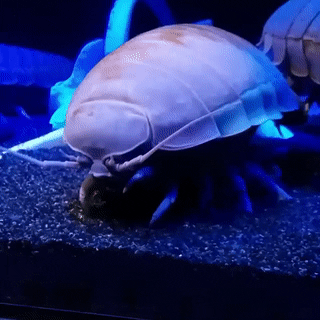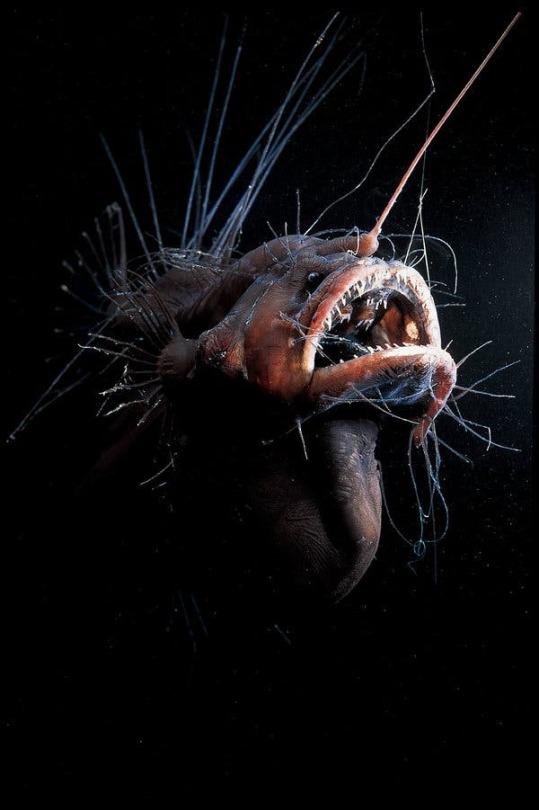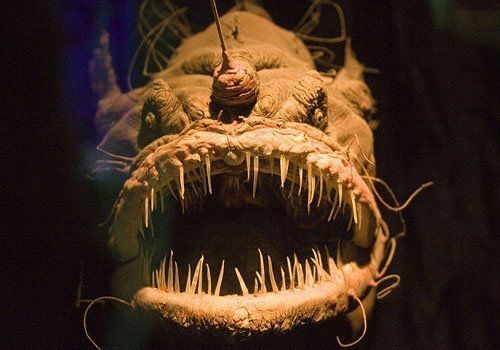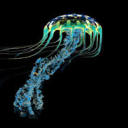Gulper Eel


Gulper Eel
Saccopharynx sp.
The Gulper Eel is known for its massive jaws, which are capable of swallowing prey whole. It’s stomach is also able to expand twice its size. It is found only in the deep see about 2000 to 3000 meters in depth.
Photo credit: https://www.youtube.com/watch?v=XRO0IjSoHGA
https://marinebiochemistrygc2018.weebly.com/deep-sea-adaptations
More Posts from Bioluminescentoceangoddess and Others


Black-devil anglerfish
Melanoncetus johnsoni
The Black-devil anglerfish is a skilled predator that lurks in the darkness. It uses a bioluminescent organ, a top its head, to lure unsuspecting prey into its jaws. Even though these fish are terrifying to look at, they are about the size of a grape fruit. To save energy, they remain immobile in the water, yet they can detect even the slightest vibrations. Since finding a mate is hard at this depth, male fish will attach themselves to a female and slowly dissolve into her tissue; so she is able to use the sperm the male provides at any time. In addition, this is the fish that tried to eat Marlin and Dory in “Finding Nemo.”
Photo credit: https://underthevastblueseas.tumblr.com/post/40882487364/this-female-black-devil-anglerfish-with-her-flabby
https://www.pinterest.fr/pin/574631233709001328/


Giant Isopod
Bathynomus kensleyi
The Giant Isopod is an unsettling deep sea creature that crawls along the ocean floor scavenging for animal remains and detritus. These invertebrates are part of phenomenon known as abyssal gigantism, which is the tendency for deep-sea dwelling invertebrates to be larger than their shallower-water counter parts. The Giant Isopod is found between 310m to 2140m in the ocean.
Photo credit
https://seatrench.tumblr.com/post/615873390014791680/giant-isopod-bathynomus-sp-source
https://alchetron.com/Giant-isopod


Cigar Comb Jelly
beroe forskalii
The Cigar Comb Jelly is a gelatinous ctenophore that is marveled by many due to its sparkling bioluminescence. It tends to elegantly float around 120 m in the ocean. It uses unique, hair-like structures called ctens to move horizontally in the ocean. It also swims in a spiral pattern before consuming zooplankton in the ocean.
Photo credit: https://www.wrobelphoto.com/gelatinouszooplankton/h25347306
https://www.flickr.com/photos/a_migotto/27227530815



Fangtooth
Anoplogaster cornuta
The Fangtooth is a ferocious predator that is found at depths between 600 m to 5000 m. It has large, needle like teeth that are used to catch prey. It also has extremely sensitive sensory canals underneath of its scales used to detect movement in the water. Furthermore, their preferred prey are crustaceans and fish.
Photo credit: https://pixels.com/featured/fangtooth-fish-dant-fenolio.html
https://www.pinterest.com/pin/845902742487789950/
https://www.newscientist.com/article/mg23231020-400-up-close-with-the-giant-teeth-of-the-deepsea-fangtooth/

Periphyllopsis braueri
The Periphyllopsis braueri is a tiny, deep sea jellyfish that is only 6 cm in diameter. It is red-chocolate in color, and it has eight gonads. Furthermore, it is found at depths between 600m to 1000m.
Photo credit: https://oceanexplorer.noaa.gov/explorations/19gulfofalaska/logs/aug2/aug2.html


Fanfin Seadevil
Caulophyyne jordani
The Fanfin Seadevil is an ugly, deep fish that is covered in gnarled skin and long sensory filaments. The sensory filaments allow this species of anglerfish to detect movement in the water; this helps the Fanfin find and lure its prey. Furthermore, this deformed monstrosity can be found floating between 700m to 3000m in the ocean.
Photo credit: https://www.nytimes.com/2019/07/29/science/anglerfish-bioluminescence-deep-sea.html
http://www.robotspacebrain.com/alien-creatures-of-the-mariana-trench/


Lav Polyp
leuckartiara octona
The Lav Polypo is a jelly that comes in a variety of colors and shapes; it dwells about 200m in the deep ocean. The red mass inside its translucent bell is the jelly’s reproductive organs. Furthermore, it uses its dull, yellow tentacles can catch unsuspecting prey.
Photo credit: https://www.pinterest.com/pin/65935582019848580/
https://www.petjellyfish.co.uk/shop/live-jellyfish/leuckartiara-octona


Wolftrap Angler
Thaumatichthys binghami
The Wolftrap Angler is slightly different from many other species of anglers. It has its bioluminescent lure located inside of its mouth instead of connected to its body. Even though it is intimidating up close, it is only nine centimeters in size. It is found in the deep ocean at 2432m.
Photo credit
https://en.wikipedia.org/wiki/Thaumatichthys_binghami
https://igniteyourcuriosity.wordpress.com/2016/10/22/anglerfish/


Pink Helmet
Aglantha digitale
The Pink Helmet is a mini hydromedusa that comes in a variety of vibrant colors. The tiny jelly is only 4 cm in size and is found towards the surface of the ocean. The purple and blue hues we see in its bell are caused by a phenomenon known as iridescence, when light strikes the jelly’s thin tissue at different angles (similar to what we see in a soap bubbles). It also has orange pigmentation near its mouth; this pigmentation helps attract prey and mask luminescence. Furthermore, females tend to be more colorful than males.
Photo credit: https://biolum.eemb.ucsb.edu/organism/pictures/aglantha.html
https://www.pinterest.com/pin/186899453255850798/

Brittle Stars
Asteroschema Ajax
Brittle stars are in the phylum Enchinodermata and are closely related to sea stars. They have long stringy arms and small podia on the bottoms of their body. They also have a hydrostatic skeleton and have a complex water vascular system. When attacked, they will abandon their arm to confuse predators and make a hasty escape. The photo above is a deep sea brittle star that lives in coral reefs.
Photo credit: https://species.wikimedia.org/wiki/Asteroschema_ajax
-
 tekniklr reblogged this · 1 year ago
tekniklr reblogged this · 1 year ago -
 jamesternes liked this · 1 year ago
jamesternes liked this · 1 year ago -
 tekniklr liked this · 1 year ago
tekniklr liked this · 1 year ago -
 creakingcrow liked this · 1 year ago
creakingcrow liked this · 1 year ago -
 magdalena-of-the-tower liked this · 1 year ago
magdalena-of-the-tower liked this · 1 year ago -
 absolutesciencefiction reblogged this · 1 year ago
absolutesciencefiction reblogged this · 1 year ago -
 androidsghost liked this · 1 year ago
androidsghost liked this · 1 year ago -
 nightingaleinberkleysquare liked this · 1 year ago
nightingaleinberkleysquare liked this · 1 year ago -
 zenidogsworld liked this · 1 year ago
zenidogsworld liked this · 1 year ago -
 canisbeta reblogged this · 1 year ago
canisbeta reblogged this · 1 year ago -
 mushroominawaterbottle liked this · 1 year ago
mushroominawaterbottle liked this · 1 year ago -
 mrnsrrw liked this · 1 year ago
mrnsrrw liked this · 1 year ago -
 stardustandmoonflowers liked this · 1 year ago
stardustandmoonflowers liked this · 1 year ago -
 lemon-lime-lauren reblogged this · 1 year ago
lemon-lime-lauren reblogged this · 1 year ago -
 dragoonmagic liked this · 1 year ago
dragoonmagic liked this · 1 year ago -
 merpdaberp liked this · 1 year ago
merpdaberp liked this · 1 year ago -
 holofoils reblogged this · 2 years ago
holofoils reblogged this · 2 years ago -
 catdemonkaid reblogged this · 2 years ago
catdemonkaid reblogged this · 2 years ago -
 rightflank reblogged this · 2 years ago
rightflank reblogged this · 2 years ago -
 dontmineit reblogged this · 2 years ago
dontmineit reblogged this · 2 years ago -
 crowfluff reblogged this · 2 years ago
crowfluff reblogged this · 2 years ago -
 gayassholeposts liked this · 2 years ago
gayassholeposts liked this · 2 years ago -
 couldhavechoosensthbetter liked this · 2 years ago
couldhavechoosensthbetter liked this · 2 years ago -
 hunty627 liked this · 2 years ago
hunty627 liked this · 2 years ago -
 saltmatchescandlewax reblogged this · 2 years ago
saltmatchescandlewax reblogged this · 2 years ago -
 anemonether liked this · 2 years ago
anemonether liked this · 2 years ago -
 amethysthorizon reblogged this · 3 years ago
amethysthorizon reblogged this · 3 years ago -
 rhincodon-cynocephalus liked this · 3 years ago
rhincodon-cynocephalus liked this · 3 years ago -
 ssoftplastic liked this · 3 years ago
ssoftplastic liked this · 3 years ago -
 wormslurry liked this · 3 years ago
wormslurry liked this · 3 years ago -
 dreaml0gic liked this · 3 years ago
dreaml0gic liked this · 3 years ago -
 aganatis liked this · 3 years ago
aganatis liked this · 3 years ago -
 pictures-and-things-321 liked this · 3 years ago
pictures-and-things-321 liked this · 3 years ago -
 crtgrt liked this · 3 years ago
crtgrt liked this · 3 years ago -
 takato1993 reblogged this · 3 years ago
takato1993 reblogged this · 3 years ago -
 blueorandas reblogged this · 3 years ago
blueorandas reblogged this · 3 years ago -
 blueorandas liked this · 3 years ago
blueorandas liked this · 3 years ago -
 quantumsplitting liked this · 3 years ago
quantumsplitting liked this · 3 years ago -
 1eldiablo6 liked this · 3 years ago
1eldiablo6 liked this · 3 years ago -
 hydrozoaa reblogged this · 3 years ago
hydrozoaa reblogged this · 3 years ago -
 sleppybitch liked this · 3 years ago
sleppybitch liked this · 3 years ago -
 hugolikesjellyfish reblogged this · 3 years ago
hugolikesjellyfish reblogged this · 3 years ago -
 dippindotssz liked this · 3 years ago
dippindotssz liked this · 3 years ago -
 holdmejustbecavse liked this · 3 years ago
holdmejustbecavse liked this · 3 years ago -
 trash--cats liked this · 3 years ago
trash--cats liked this · 3 years ago

Bioluminescence is a chemical reaction that produces light. Many deep sea animals use bioluminescence. This blog is dedicated to educating the public about the amazing creatures that thrive in the deep sea.
57 posts